Provision of Care for Children
VerifiedAdded on 2023/06/03
|15
|4158
|478
AI Summary
Learn about the provision of care for children, including feeding, mealtime environment, changing diapers, toileting, physical activity, and feeding an infant. Improve your knowledge of Early Childhood Education and Care.
Contribute Materials
Your contribution can guide someone’s learning journey. Share your
documents today.
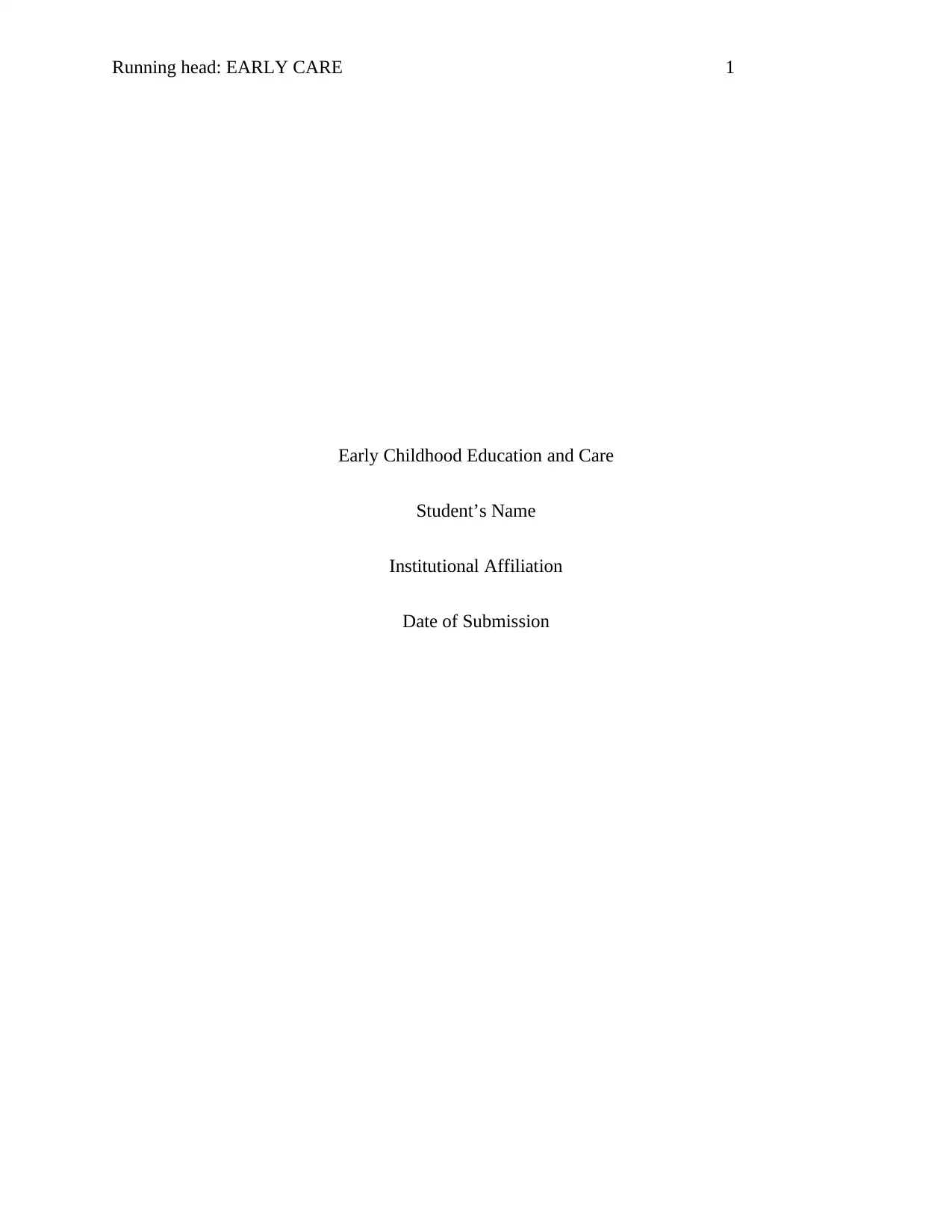
Running head: EARLY CARE 1
Early Childhood Education and Care
Student’s Name
Institutional Affiliation
Date of Submission
Early Childhood Education and Care
Student’s Name
Institutional Affiliation
Date of Submission
Secure Best Marks with AI Grader
Need help grading? Try our AI Grader for instant feedback on your assignments.

EARLY CARE 2
Provision of Care for Children
a) Food and Drinks Preparation
In the preparation of meals for toddlers below 24months, I can engage them by asking them
about their favorite meals. I can also ask them to recite their home menus. Toddlers are required
to eat a variety of dishes each day. As a result, I have prepared my own food guide for toddlers
within the stipulated ages of one to two years. According to my food guide, all foods with high
fat and sugar are limited to give room for healthy foods. Toddlers will not be given too much
juice, milk, or drinks that are sugary because they literally fill up toddlers. Such foods make
toddlers have poor appetite thereby making them have no taste for foods that are important and
would help them grow healthy and strong (Australian Government, 2017).
The foods given to toddlers should also be able to prevent tooth decay. To ensure that the
children under my care do not suffer from tooth decay, I will let them drink fluids from small
cups that have spill-proof tops. Afterward, I will let them practice drinking from cups without the
spill-proof tops. They will not be sipping juice, sweet drinks, or milk frequently but they will be
given water instead; particularly when they are thirsty between meals (Hardy, Mihrshahi,
Drayton, & Bauman, 2016).
While eating, toddlers are likely to choke. To avoid choking, children are required to sit in an
upright position when eating. I will then tell them to take small chunks and bit them then chew
completely to before they swallow the chunks. Apart from that, I will cut fruits that are soft as
well as cooked vegetables into tiny pieces (the pieces should be in neither coin-shapes nor small
pieces). I will then remove seeds, the tough skins, and pits. In addition, fruits such as cherries,
grapes, or berries need to be cut in tiny pieces as mentioned before. Meats that are sausage-
Provision of Care for Children
a) Food and Drinks Preparation
In the preparation of meals for toddlers below 24months, I can engage them by asking them
about their favorite meals. I can also ask them to recite their home menus. Toddlers are required
to eat a variety of dishes each day. As a result, I have prepared my own food guide for toddlers
within the stipulated ages of one to two years. According to my food guide, all foods with high
fat and sugar are limited to give room for healthy foods. Toddlers will not be given too much
juice, milk, or drinks that are sugary because they literally fill up toddlers. Such foods make
toddlers have poor appetite thereby making them have no taste for foods that are important and
would help them grow healthy and strong (Australian Government, 2017).
The foods given to toddlers should also be able to prevent tooth decay. To ensure that the
children under my care do not suffer from tooth decay, I will let them drink fluids from small
cups that have spill-proof tops. Afterward, I will let them practice drinking from cups without the
spill-proof tops. They will not be sipping juice, sweet drinks, or milk frequently but they will be
given water instead; particularly when they are thirsty between meals (Hardy, Mihrshahi,
Drayton, & Bauman, 2016).
While eating, toddlers are likely to choke. To avoid choking, children are required to sit in an
upright position when eating. I will then tell them to take small chunks and bit them then chew
completely to before they swallow the chunks. Apart from that, I will cut fruits that are soft as
well as cooked vegetables into tiny pieces (the pieces should be in neither coin-shapes nor small
pieces). I will then remove seeds, the tough skins, and pits. In addition, fruits such as cherries,
grapes, or berries need to be cut in tiny pieces as mentioned before. Meats that are sausage-
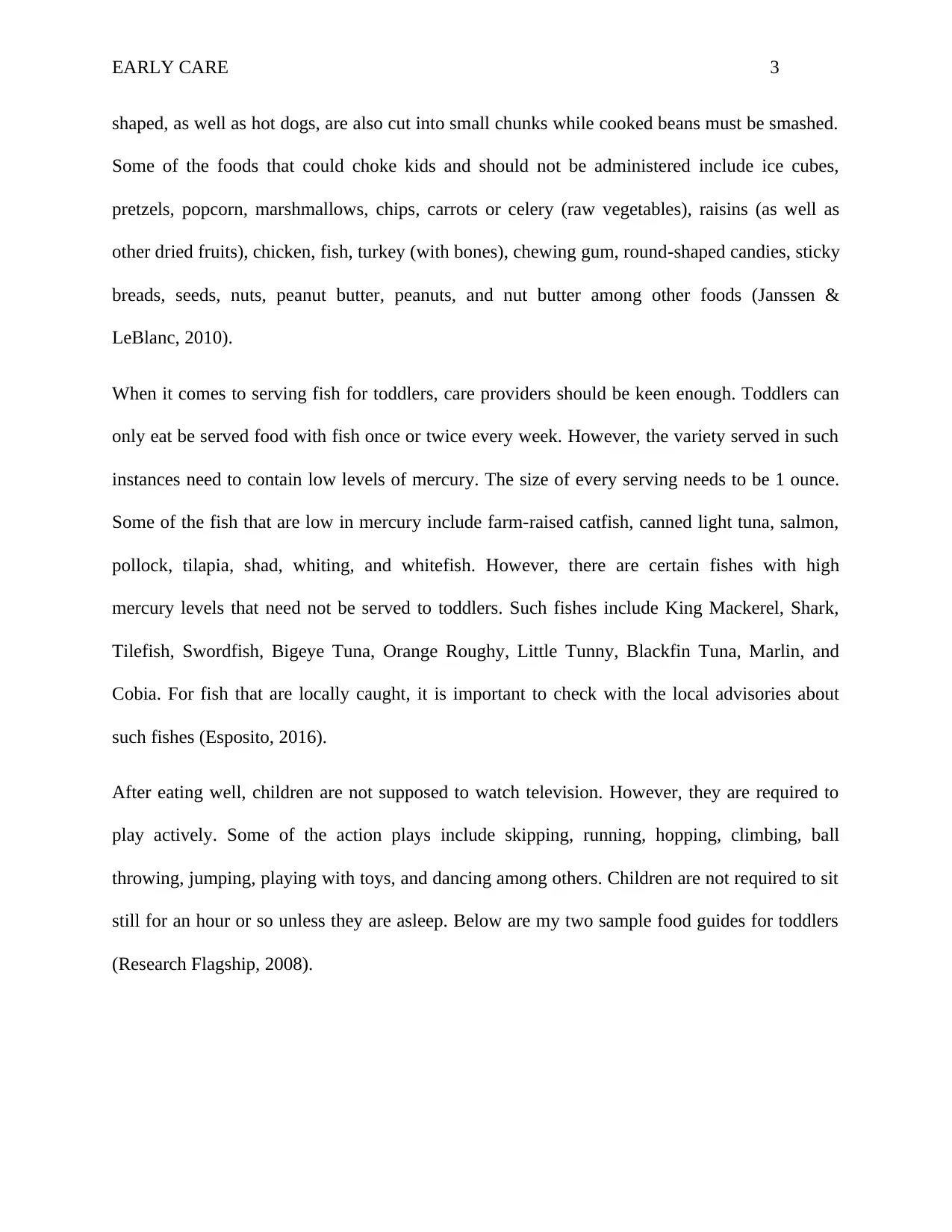
EARLY CARE 3
shaped, as well as hot dogs, are also cut into small chunks while cooked beans must be smashed.
Some of the foods that could choke kids and should not be administered include ice cubes,
pretzels, popcorn, marshmallows, chips, carrots or celery (raw vegetables), raisins (as well as
other dried fruits), chicken, fish, turkey (with bones), chewing gum, round-shaped candies, sticky
breads, seeds, nuts, peanut butter, peanuts, and nut butter among other foods (Janssen &
LeBlanc, 2010).
When it comes to serving fish for toddlers, care providers should be keen enough. Toddlers can
only eat be served food with fish once or twice every week. However, the variety served in such
instances need to contain low levels of mercury. The size of every serving needs to be 1 ounce.
Some of the fish that are low in mercury include farm-raised catfish, canned light tuna, salmon,
pollock, tilapia, shad, whiting, and whitefish. However, there are certain fishes with high
mercury levels that need not be served to toddlers. Such fishes include King Mackerel, Shark,
Tilefish, Swordfish, Bigeye Tuna, Orange Roughy, Little Tunny, Blackfin Tuna, Marlin, and
Cobia. For fish that are locally caught, it is important to check with the local advisories about
such fishes (Esposito, 2016).
After eating well, children are not supposed to watch television. However, they are required to
play actively. Some of the action plays include skipping, running, hopping, climbing, ball
throwing, jumping, playing with toys, and dancing among others. Children are not required to sit
still for an hour or so unless they are asleep. Below are my two sample food guides for toddlers
(Research Flagship, 2008).
shaped, as well as hot dogs, are also cut into small chunks while cooked beans must be smashed.
Some of the foods that could choke kids and should not be administered include ice cubes,
pretzels, popcorn, marshmallows, chips, carrots or celery (raw vegetables), raisins (as well as
other dried fruits), chicken, fish, turkey (with bones), chewing gum, round-shaped candies, sticky
breads, seeds, nuts, peanut butter, peanuts, and nut butter among other foods (Janssen &
LeBlanc, 2010).
When it comes to serving fish for toddlers, care providers should be keen enough. Toddlers can
only eat be served food with fish once or twice every week. However, the variety served in such
instances need to contain low levels of mercury. The size of every serving needs to be 1 ounce.
Some of the fish that are low in mercury include farm-raised catfish, canned light tuna, salmon,
pollock, tilapia, shad, whiting, and whitefish. However, there are certain fishes with high
mercury levels that need not be served to toddlers. Such fishes include King Mackerel, Shark,
Tilefish, Swordfish, Bigeye Tuna, Orange Roughy, Little Tunny, Blackfin Tuna, Marlin, and
Cobia. For fish that are locally caught, it is important to check with the local advisories about
such fishes (Esposito, 2016).
After eating well, children are not supposed to watch television. However, they are required to
play actively. Some of the action plays include skipping, running, hopping, climbing, ball
throwing, jumping, playing with toys, and dancing among others. Children are not required to sit
still for an hour or so unless they are asleep. Below are my two sample food guides for toddlers
(Research Flagship, 2008).
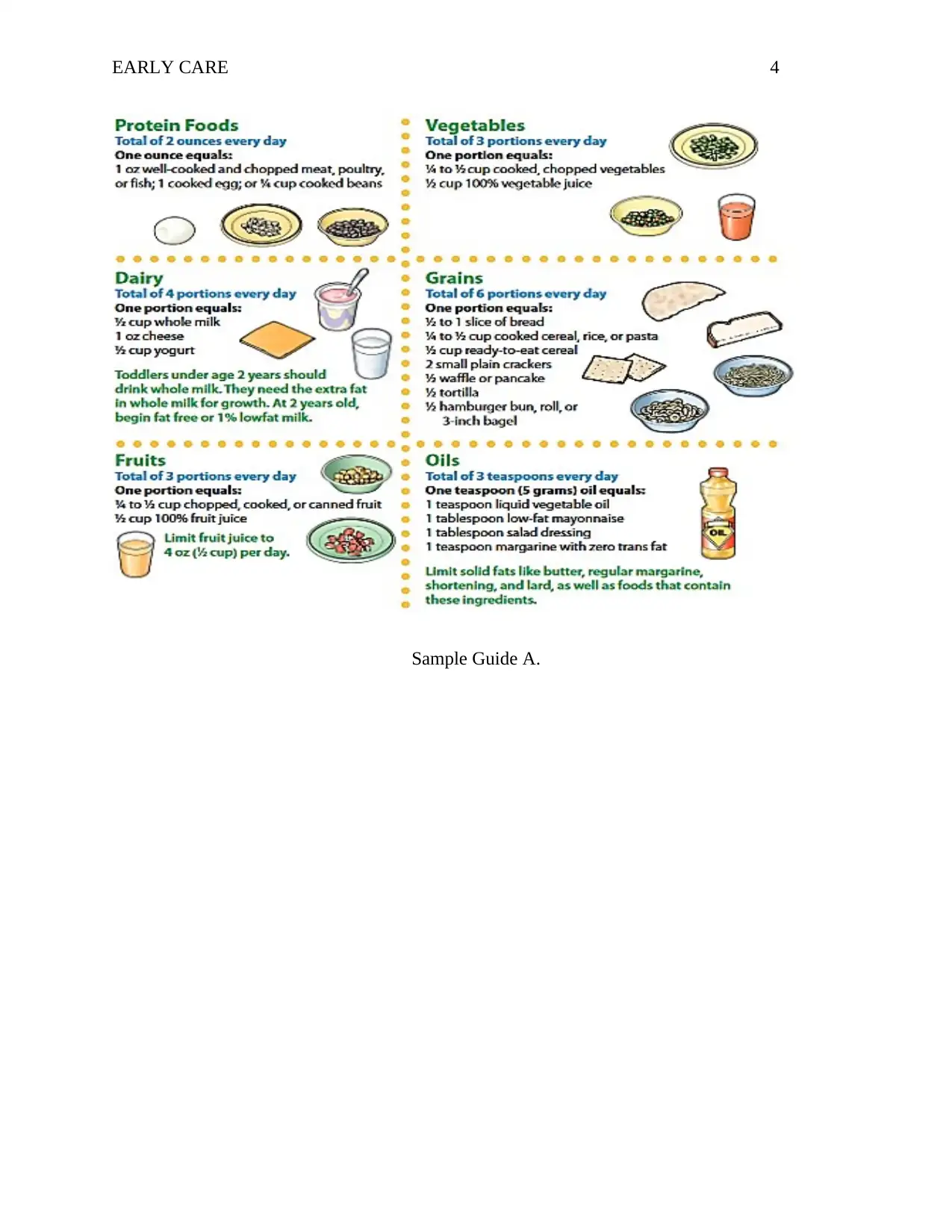
EARLY CARE 4
Sample Guide A.
Sample Guide A.
Secure Best Marks with AI Grader
Need help grading? Try our AI Grader for instant feedback on your assignments.
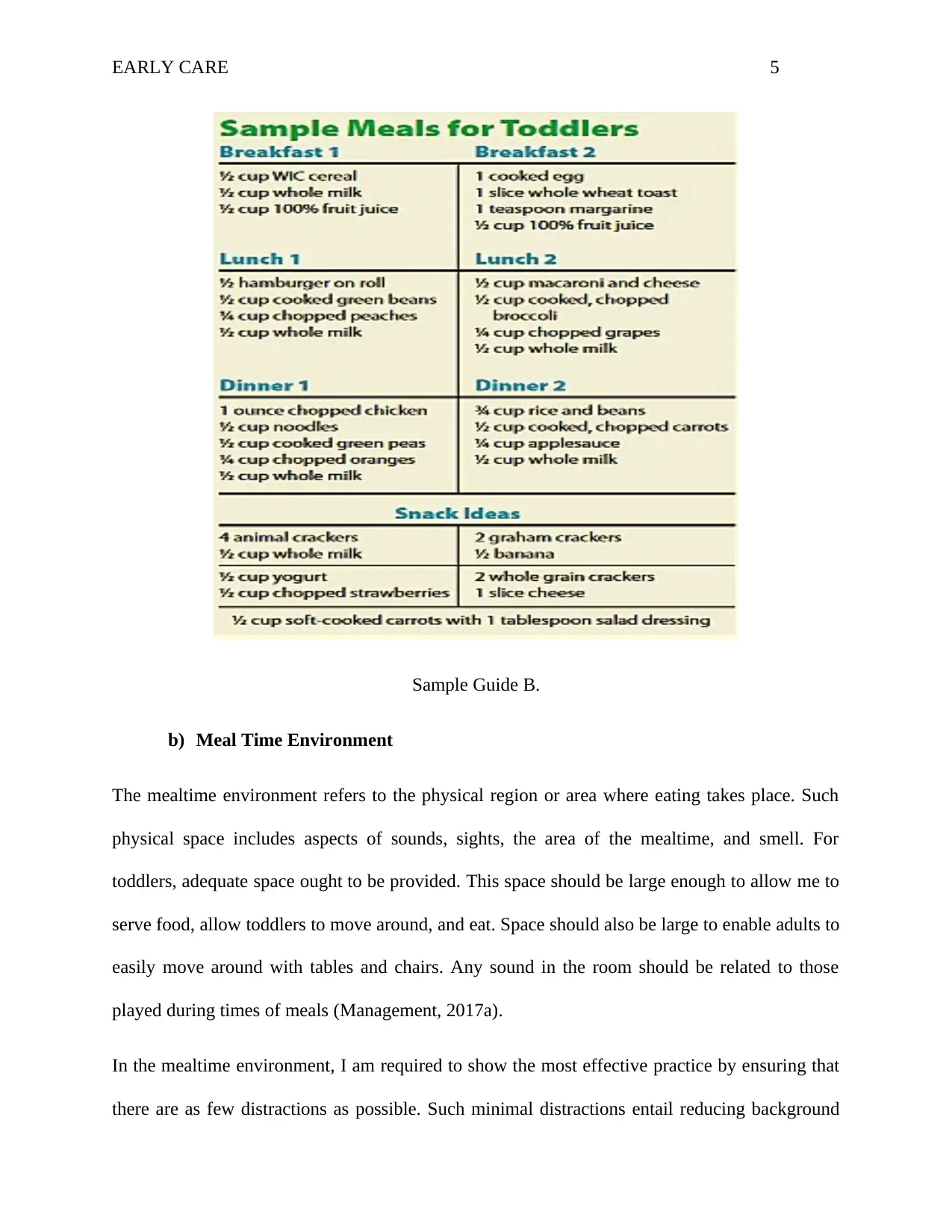
EARLY CARE 5
Sample Guide B.
b) Meal Time Environment
The mealtime environment refers to the physical region or area where eating takes place. Such
physical space includes aspects of sounds, sights, the area of the mealtime, and smell. For
toddlers, adequate space ought to be provided. This space should be large enough to allow me to
serve food, allow toddlers to move around, and eat. Space should also be large to enable adults to
easily move around with tables and chairs. Any sound in the room should be related to those
played during times of meals (Management, 2017a).
In the mealtime environment, I am required to show the most effective practice by ensuring that
there are as few distractions as possible. Such minimal distractions entail reducing background
Sample Guide B.
b) Meal Time Environment
The mealtime environment refers to the physical region or area where eating takes place. Such
physical space includes aspects of sounds, sights, the area of the mealtime, and smell. For
toddlers, adequate space ought to be provided. This space should be large enough to allow me to
serve food, allow toddlers to move around, and eat. Space should also be large to enable adults to
easily move around with tables and chairs. Any sound in the room should be related to those
played during times of meals (Management, 2017a).
In the mealtime environment, I am required to show the most effective practice by ensuring that
there are as few distractions as possible. Such minimal distractions entail reducing background
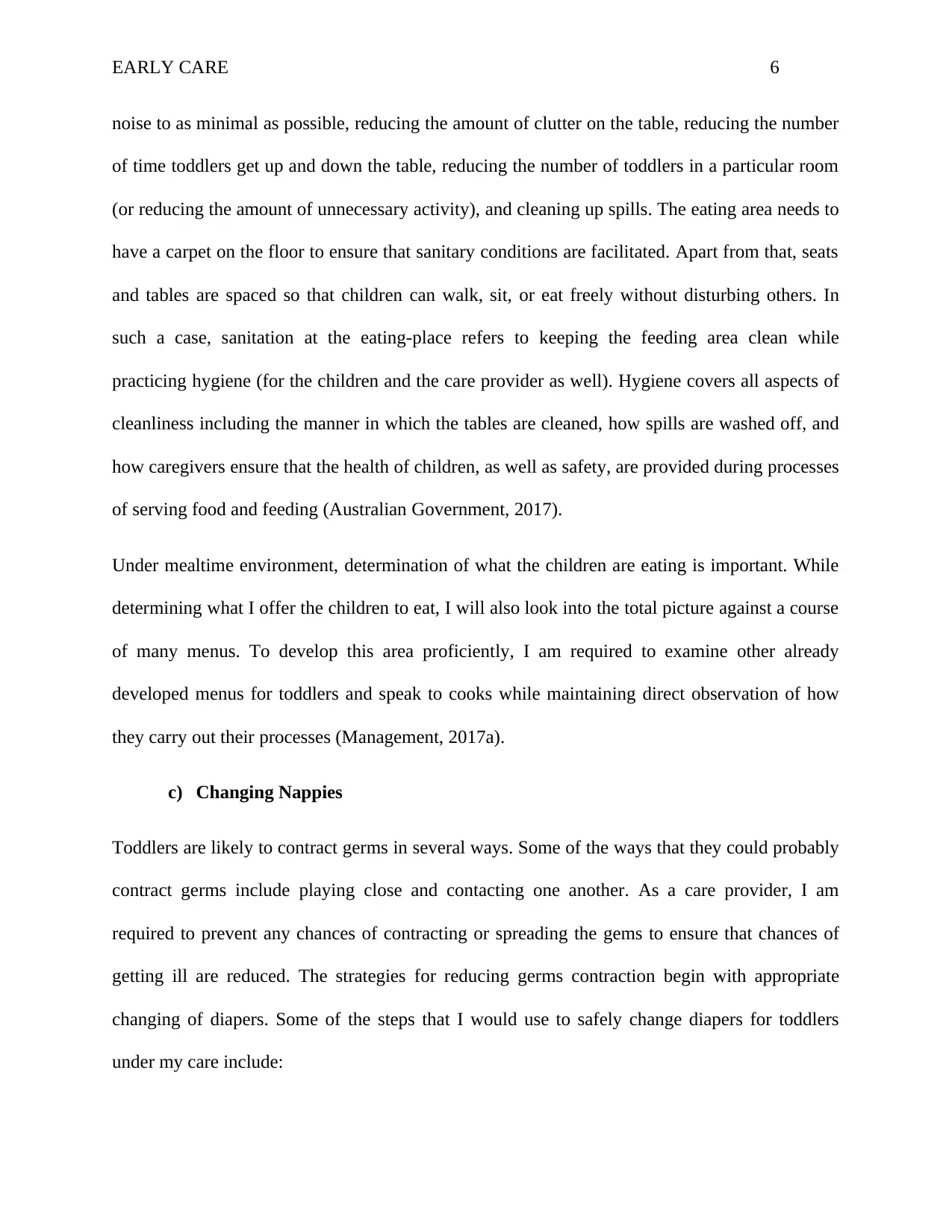
EARLY CARE 6
noise to as minimal as possible, reducing the amount of clutter on the table, reducing the number
of time toddlers get up and down the table, reducing the number of toddlers in a particular room
(or reducing the amount of unnecessary activity), and cleaning up spills. The eating area needs to
have a carpet on the floor to ensure that sanitary conditions are facilitated. Apart from that, seats
and tables are spaced so that children can walk, sit, or eat freely without disturbing others. In
such a case, sanitation at the eating-place refers to keeping the feeding area clean while
practicing hygiene (for the children and the care provider as well). Hygiene covers all aspects of
cleanliness including the manner in which the tables are cleaned, how spills are washed off, and
how caregivers ensure that the health of children, as well as safety, are provided during processes
of serving food and feeding (Australian Government, 2017).
Under mealtime environment, determination of what the children are eating is important. While
determining what I offer the children to eat, I will also look into the total picture against a course
of many menus. To develop this area proficiently, I am required to examine other already
developed menus for toddlers and speak to cooks while maintaining direct observation of how
they carry out their processes (Management, 2017a).
c) Changing Nappies
Toddlers are likely to contract germs in several ways. Some of the ways that they could probably
contract germs include playing close and contacting one another. As a care provider, I am
required to prevent any chances of contracting or spreading the gems to ensure that chances of
getting ill are reduced. The strategies for reducing germs contraction begin with appropriate
changing of diapers. Some of the steps that I would use to safely change diapers for toddlers
under my care include:
noise to as minimal as possible, reducing the amount of clutter on the table, reducing the number
of time toddlers get up and down the table, reducing the number of toddlers in a particular room
(or reducing the amount of unnecessary activity), and cleaning up spills. The eating area needs to
have a carpet on the floor to ensure that sanitary conditions are facilitated. Apart from that, seats
and tables are spaced so that children can walk, sit, or eat freely without disturbing others. In
such a case, sanitation at the eating-place refers to keeping the feeding area clean while
practicing hygiene (for the children and the care provider as well). Hygiene covers all aspects of
cleanliness including the manner in which the tables are cleaned, how spills are washed off, and
how caregivers ensure that the health of children, as well as safety, are provided during processes
of serving food and feeding (Australian Government, 2017).
Under mealtime environment, determination of what the children are eating is important. While
determining what I offer the children to eat, I will also look into the total picture against a course
of many menus. To develop this area proficiently, I am required to examine other already
developed menus for toddlers and speak to cooks while maintaining direct observation of how
they carry out their processes (Management, 2017a).
c) Changing Nappies
Toddlers are likely to contract germs in several ways. Some of the ways that they could probably
contract germs include playing close and contacting one another. As a care provider, I am
required to prevent any chances of contracting or spreading the gems to ensure that chances of
getting ill are reduced. The strategies for reducing germs contraction begin with appropriate
changing of diapers. Some of the steps that I would use to safely change diapers for toddlers
under my care include:
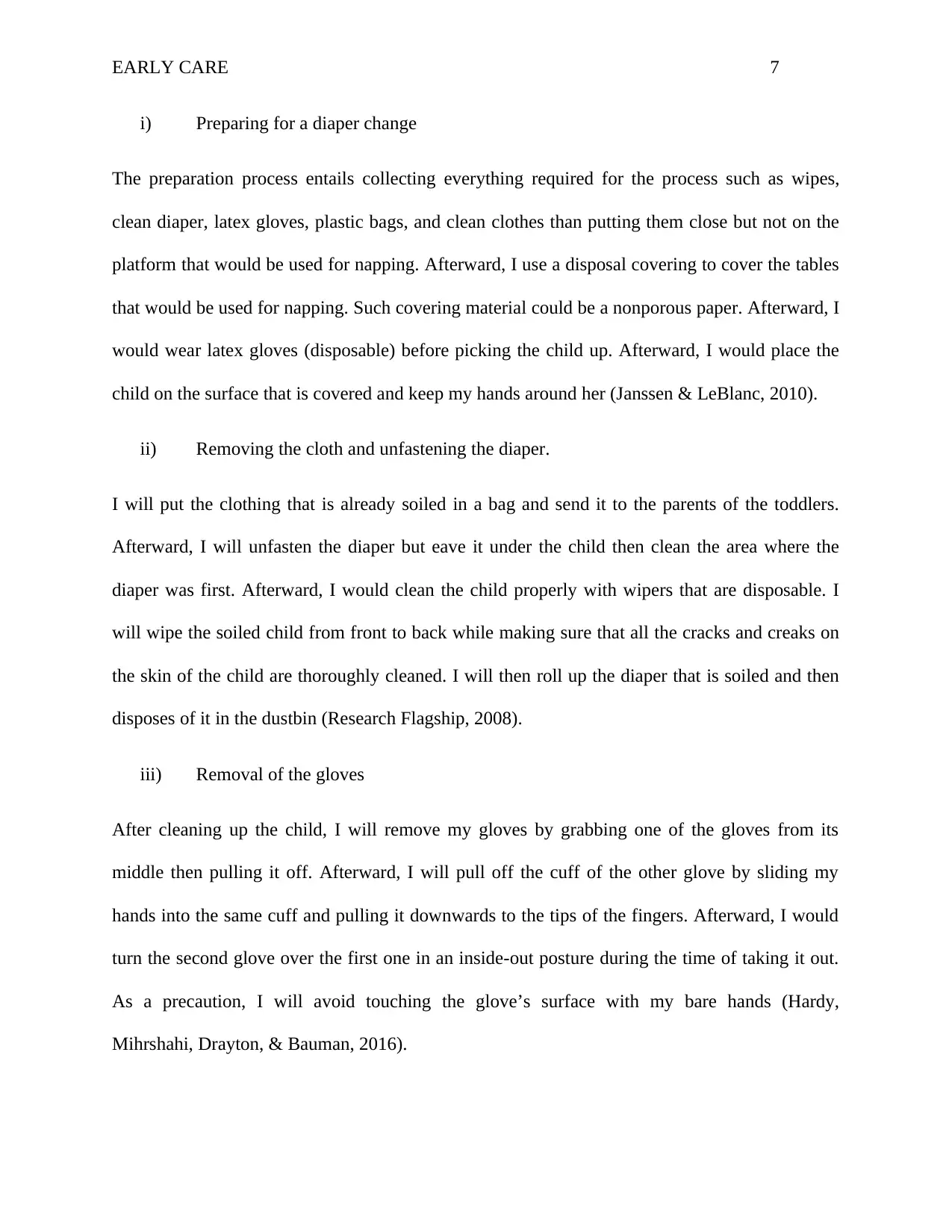
EARLY CARE 7
i) Preparing for a diaper change
The preparation process entails collecting everything required for the process such as wipes,
clean diaper, latex gloves, plastic bags, and clean clothes than putting them close but not on the
platform that would be used for napping. Afterward, I use a disposal covering to cover the tables
that would be used for napping. Such covering material could be a nonporous paper. Afterward, I
would wear latex gloves (disposable) before picking the child up. Afterward, I would place the
child on the surface that is covered and keep my hands around her (Janssen & LeBlanc, 2010).
ii) Removing the cloth and unfastening the diaper.
I will put the clothing that is already soiled in a bag and send it to the parents of the toddlers.
Afterward, I will unfasten the diaper but eave it under the child then clean the area where the
diaper was first. Afterward, I would clean the child properly with wipers that are disposable. I
will wipe the soiled child from front to back while making sure that all the cracks and creaks on
the skin of the child are thoroughly cleaned. I will then roll up the diaper that is soiled and then
disposes of it in the dustbin (Research Flagship, 2008).
iii) Removal of the gloves
After cleaning up the child, I will remove my gloves by grabbing one of the gloves from its
middle then pulling it off. Afterward, I will pull off the cuff of the other glove by sliding my
hands into the same cuff and pulling it downwards to the tips of the fingers. Afterward, I would
turn the second glove over the first one in an inside-out posture during the time of taking it out.
As a precaution, I will avoid touching the glove’s surface with my bare hands (Hardy,
Mihrshahi, Drayton, & Bauman, 2016).
i) Preparing for a diaper change
The preparation process entails collecting everything required for the process such as wipes,
clean diaper, latex gloves, plastic bags, and clean clothes than putting them close but not on the
platform that would be used for napping. Afterward, I use a disposal covering to cover the tables
that would be used for napping. Such covering material could be a nonporous paper. Afterward, I
would wear latex gloves (disposable) before picking the child up. Afterward, I would place the
child on the surface that is covered and keep my hands around her (Janssen & LeBlanc, 2010).
ii) Removing the cloth and unfastening the diaper.
I will put the clothing that is already soiled in a bag and send it to the parents of the toddlers.
Afterward, I will unfasten the diaper but eave it under the child then clean the area where the
diaper was first. Afterward, I would clean the child properly with wipers that are disposable. I
will wipe the soiled child from front to back while making sure that all the cracks and creaks on
the skin of the child are thoroughly cleaned. I will then roll up the diaper that is soiled and then
disposes of it in the dustbin (Research Flagship, 2008).
iii) Removal of the gloves
After cleaning up the child, I will remove my gloves by grabbing one of the gloves from its
middle then pulling it off. Afterward, I will pull off the cuff of the other glove by sliding my
hands into the same cuff and pulling it downwards to the tips of the fingers. Afterward, I would
turn the second glove over the first one in an inside-out posture during the time of taking it out.
As a precaution, I will avoid touching the glove’s surface with my bare hands (Hardy,
Mihrshahi, Drayton, & Bauman, 2016).
Paraphrase This Document
Need a fresh take? Get an instant paraphrase of this document with our AI Paraphraser
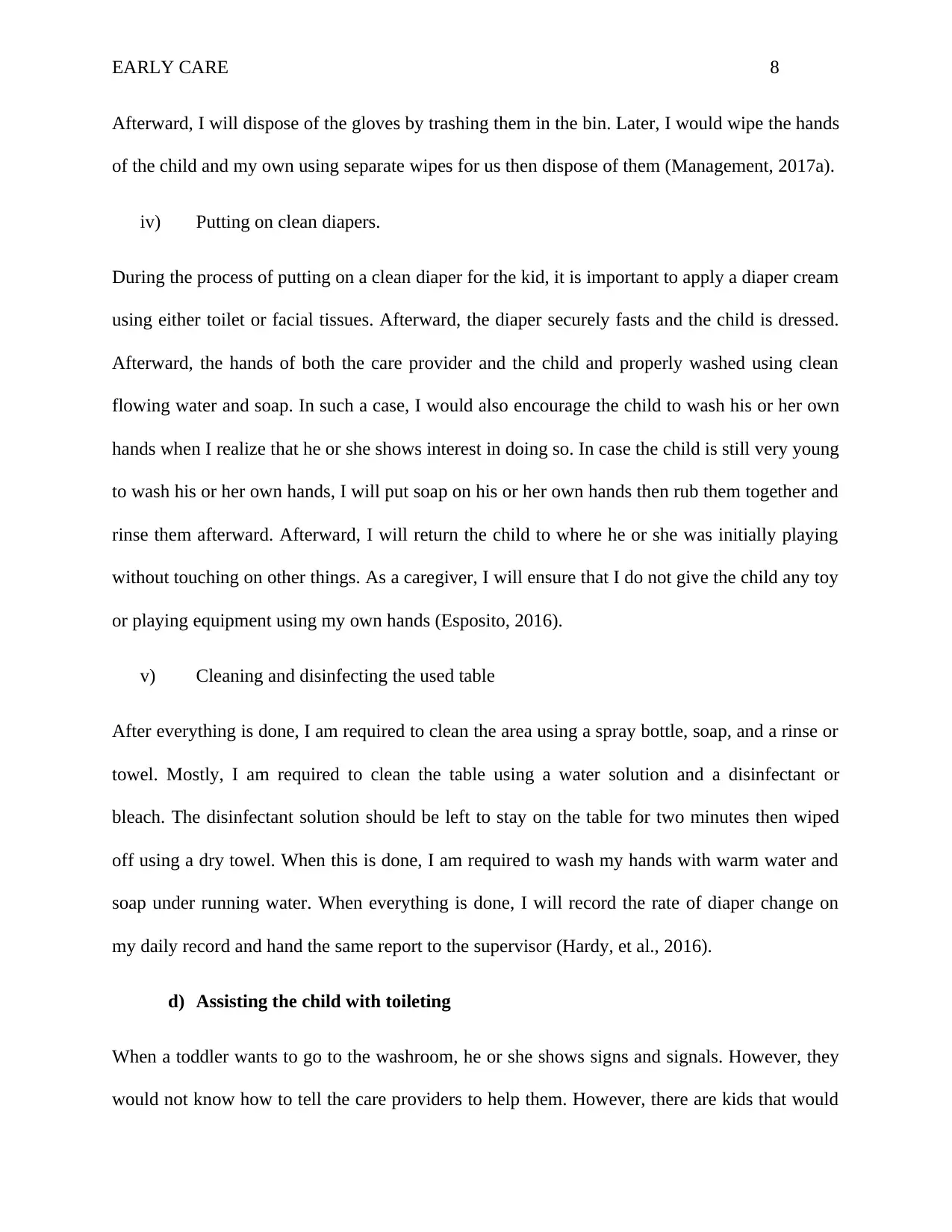
EARLY CARE 8
Afterward, I will dispose of the gloves by trashing them in the bin. Later, I would wipe the hands
of the child and my own using separate wipes for us then dispose of them (Management, 2017a).
iv) Putting on clean diapers.
During the process of putting on a clean diaper for the kid, it is important to apply a diaper cream
using either toilet or facial tissues. Afterward, the diaper securely fasts and the child is dressed.
Afterward, the hands of both the care provider and the child and properly washed using clean
flowing water and soap. In such a case, I would also encourage the child to wash his or her own
hands when I realize that he or she shows interest in doing so. In case the child is still very young
to wash his or her own hands, I will put soap on his or her own hands then rub them together and
rinse them afterward. Afterward, I will return the child to where he or she was initially playing
without touching on other things. As a caregiver, I will ensure that I do not give the child any toy
or playing equipment using my own hands (Esposito, 2016).
v) Cleaning and disinfecting the used table
After everything is done, I am required to clean the area using a spray bottle, soap, and a rinse or
towel. Mostly, I am required to clean the table using a water solution and a disinfectant or
bleach. The disinfectant solution should be left to stay on the table for two minutes then wiped
off using a dry towel. When this is done, I am required to wash my hands with warm water and
soap under running water. When everything is done, I will record the rate of diaper change on
my daily record and hand the same report to the supervisor (Hardy, et al., 2016).
d) Assisting the child with toileting
When a toddler wants to go to the washroom, he or she shows signs and signals. However, they
would not know how to tell the care providers to help them. However, there are kids that would
Afterward, I will dispose of the gloves by trashing them in the bin. Later, I would wipe the hands
of the child and my own using separate wipes for us then dispose of them (Management, 2017a).
iv) Putting on clean diapers.
During the process of putting on a clean diaper for the kid, it is important to apply a diaper cream
using either toilet or facial tissues. Afterward, the diaper securely fasts and the child is dressed.
Afterward, the hands of both the care provider and the child and properly washed using clean
flowing water and soap. In such a case, I would also encourage the child to wash his or her own
hands when I realize that he or she shows interest in doing so. In case the child is still very young
to wash his or her own hands, I will put soap on his or her own hands then rub them together and
rinse them afterward. Afterward, I will return the child to where he or she was initially playing
without touching on other things. As a caregiver, I will ensure that I do not give the child any toy
or playing equipment using my own hands (Esposito, 2016).
v) Cleaning and disinfecting the used table
After everything is done, I am required to clean the area using a spray bottle, soap, and a rinse or
towel. Mostly, I am required to clean the table using a water solution and a disinfectant or
bleach. The disinfectant solution should be left to stay on the table for two minutes then wiped
off using a dry towel. When this is done, I am required to wash my hands with warm water and
soap under running water. When everything is done, I will record the rate of diaper change on
my daily record and hand the same report to the supervisor (Hardy, et al., 2016).
d) Assisting the child with toileting
When a toddler wants to go to the washroom, he or she shows signs and signals. However, they
would not know how to tell the care providers to help them. However, there are kids that would
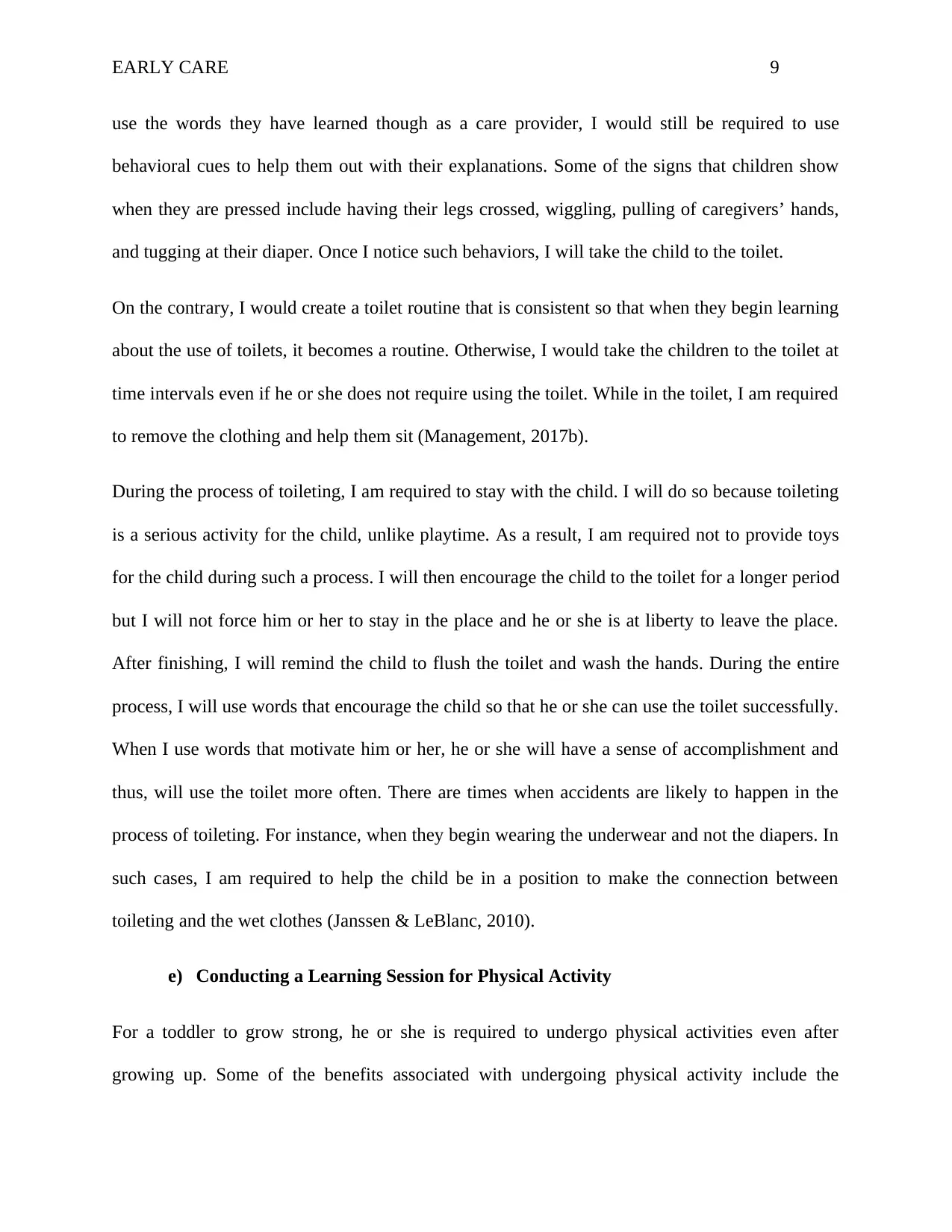
EARLY CARE 9
use the words they have learned though as a care provider, I would still be required to use
behavioral cues to help them out with their explanations. Some of the signs that children show
when they are pressed include having their legs crossed, wiggling, pulling of caregivers’ hands,
and tugging at their diaper. Once I notice such behaviors, I will take the child to the toilet.
On the contrary, I would create a toilet routine that is consistent so that when they begin learning
about the use of toilets, it becomes a routine. Otherwise, I would take the children to the toilet at
time intervals even if he or she does not require using the toilet. While in the toilet, I am required
to remove the clothing and help them sit (Management, 2017b).
During the process of toileting, I am required to stay with the child. I will do so because toileting
is a serious activity for the child, unlike playtime. As a result, I am required not to provide toys
for the child during such a process. I will then encourage the child to the toilet for a longer period
but I will not force him or her to stay in the place and he or she is at liberty to leave the place.
After finishing, I will remind the child to flush the toilet and wash the hands. During the entire
process, I will use words that encourage the child so that he or she can use the toilet successfully.
When I use words that motivate him or her, he or she will have a sense of accomplishment and
thus, will use the toilet more often. There are times when accidents are likely to happen in the
process of toileting. For instance, when they begin wearing the underwear and not the diapers. In
such cases, I am required to help the child be in a position to make the connection between
toileting and the wet clothes (Janssen & LeBlanc, 2010).
e) Conducting a Learning Session for Physical Activity
For a toddler to grow strong, he or she is required to undergo physical activities even after
growing up. Some of the benefits associated with undergoing physical activity include the
use the words they have learned though as a care provider, I would still be required to use
behavioral cues to help them out with their explanations. Some of the signs that children show
when they are pressed include having their legs crossed, wiggling, pulling of caregivers’ hands,
and tugging at their diaper. Once I notice such behaviors, I will take the child to the toilet.
On the contrary, I would create a toilet routine that is consistent so that when they begin learning
about the use of toilets, it becomes a routine. Otherwise, I would take the children to the toilet at
time intervals even if he or she does not require using the toilet. While in the toilet, I am required
to remove the clothing and help them sit (Management, 2017b).
During the process of toileting, I am required to stay with the child. I will do so because toileting
is a serious activity for the child, unlike playtime. As a result, I am required not to provide toys
for the child during such a process. I will then encourage the child to the toilet for a longer period
but I will not force him or her to stay in the place and he or she is at liberty to leave the place.
After finishing, I will remind the child to flush the toilet and wash the hands. During the entire
process, I will use words that encourage the child so that he or she can use the toilet successfully.
When I use words that motivate him or her, he or she will have a sense of accomplishment and
thus, will use the toilet more often. There are times when accidents are likely to happen in the
process of toileting. For instance, when they begin wearing the underwear and not the diapers. In
such cases, I am required to help the child be in a position to make the connection between
toileting and the wet clothes (Janssen & LeBlanc, 2010).
e) Conducting a Learning Session for Physical Activity
For a toddler to grow strong, he or she is required to undergo physical activities even after
growing up. Some of the benefits associated with undergoing physical activity include the
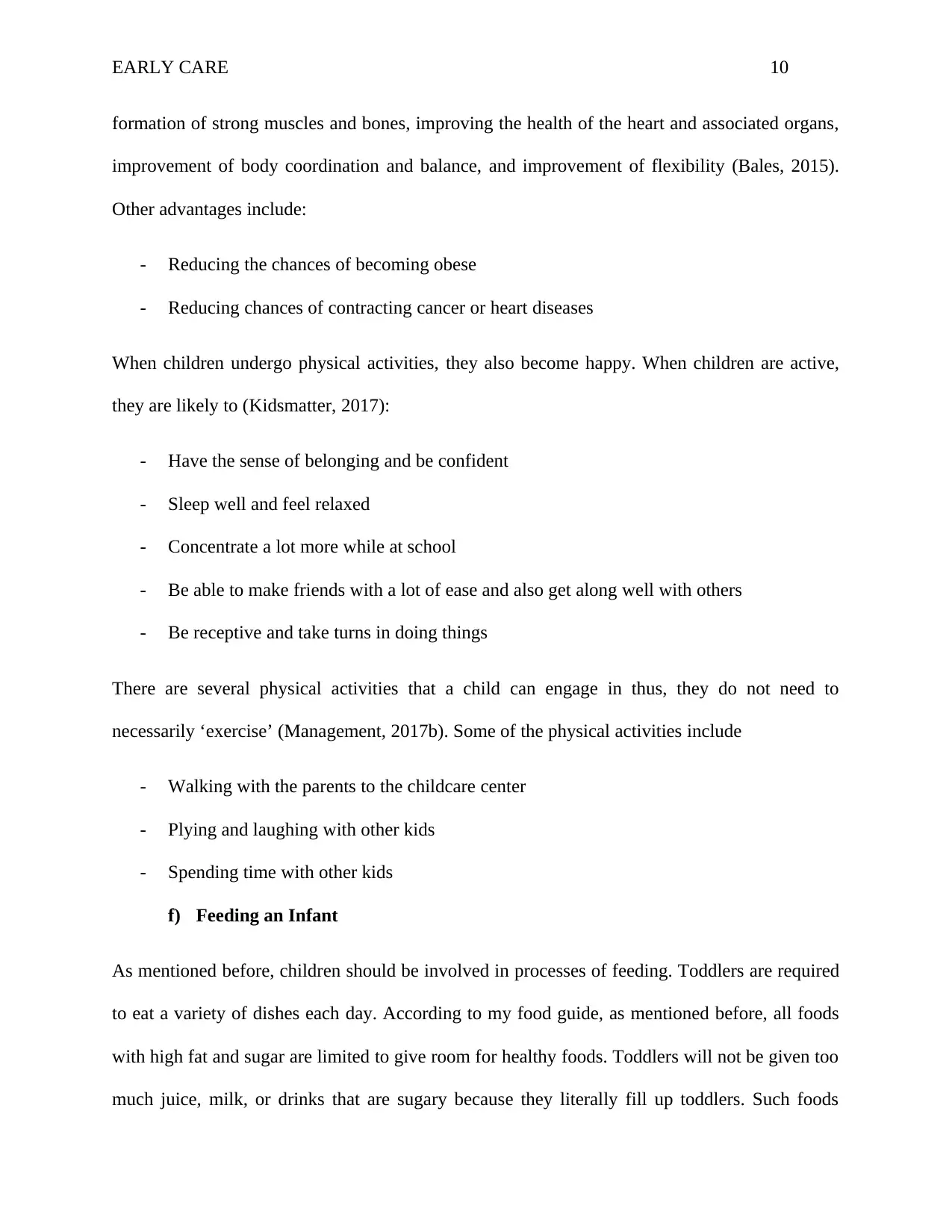
EARLY CARE 10
formation of strong muscles and bones, improving the health of the heart and associated organs,
improvement of body coordination and balance, and improvement of flexibility (Bales, 2015).
Other advantages include:
- Reducing the chances of becoming obese
- Reducing chances of contracting cancer or heart diseases
When children undergo physical activities, they also become happy. When children are active,
they are likely to (Kidsmatter, 2017):
- Have the sense of belonging and be confident
- Sleep well and feel relaxed
- Concentrate a lot more while at school
- Be able to make friends with a lot of ease and also get along well with others
- Be receptive and take turns in doing things
There are several physical activities that a child can engage in thus, they do not need to
necessarily ‘exercise’ (Management, 2017b). Some of the physical activities include
- Walking with the parents to the childcare center
- Plying and laughing with other kids
- Spending time with other kids
f) Feeding an Infant
As mentioned before, children should be involved in processes of feeding. Toddlers are required
to eat a variety of dishes each day. According to my food guide, as mentioned before, all foods
with high fat and sugar are limited to give room for healthy foods. Toddlers will not be given too
much juice, milk, or drinks that are sugary because they literally fill up toddlers. Such foods
formation of strong muscles and bones, improving the health of the heart and associated organs,
improvement of body coordination and balance, and improvement of flexibility (Bales, 2015).
Other advantages include:
- Reducing the chances of becoming obese
- Reducing chances of contracting cancer or heart diseases
When children undergo physical activities, they also become happy. When children are active,
they are likely to (Kidsmatter, 2017):
- Have the sense of belonging and be confident
- Sleep well and feel relaxed
- Concentrate a lot more while at school
- Be able to make friends with a lot of ease and also get along well with others
- Be receptive and take turns in doing things
There are several physical activities that a child can engage in thus, they do not need to
necessarily ‘exercise’ (Management, 2017b). Some of the physical activities include
- Walking with the parents to the childcare center
- Plying and laughing with other kids
- Spending time with other kids
f) Feeding an Infant
As mentioned before, children should be involved in processes of feeding. Toddlers are required
to eat a variety of dishes each day. According to my food guide, as mentioned before, all foods
with high fat and sugar are limited to give room for healthy foods. Toddlers will not be given too
much juice, milk, or drinks that are sugary because they literally fill up toddlers. Such foods
Secure Best Marks with AI Grader
Need help grading? Try our AI Grader for instant feedback on your assignments.
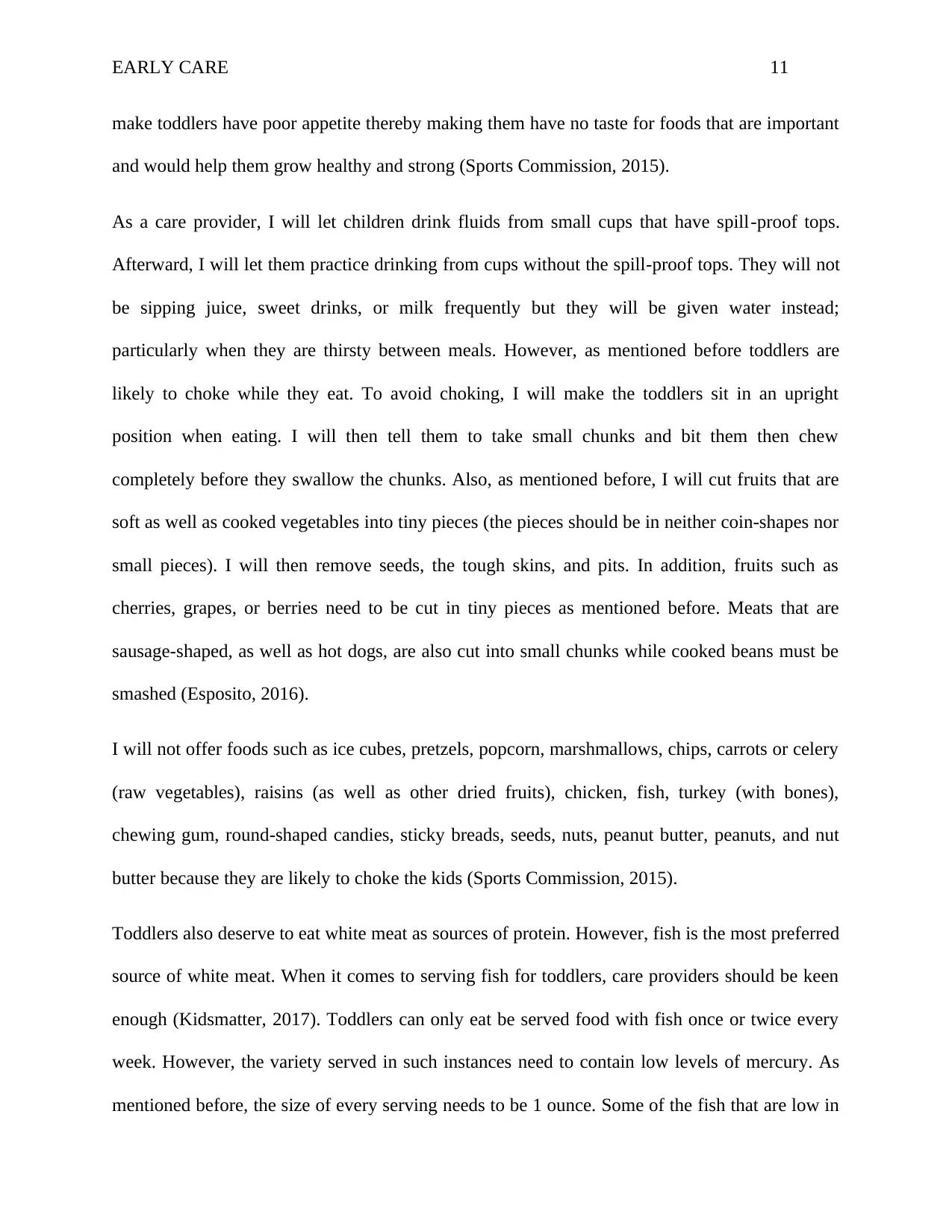
EARLY CARE 11
make toddlers have poor appetite thereby making them have no taste for foods that are important
and would help them grow healthy and strong (Sports Commission, 2015).
As a care provider, I will let children drink fluids from small cups that have spill-proof tops.
Afterward, I will let them practice drinking from cups without the spill-proof tops. They will not
be sipping juice, sweet drinks, or milk frequently but they will be given water instead;
particularly when they are thirsty between meals. However, as mentioned before toddlers are
likely to choke while they eat. To avoid choking, I will make the toddlers sit in an upright
position when eating. I will then tell them to take small chunks and bit them then chew
completely before they swallow the chunks. Also, as mentioned before, I will cut fruits that are
soft as well as cooked vegetables into tiny pieces (the pieces should be in neither coin-shapes nor
small pieces). I will then remove seeds, the tough skins, and pits. In addition, fruits such as
cherries, grapes, or berries need to be cut in tiny pieces as mentioned before. Meats that are
sausage-shaped, as well as hot dogs, are also cut into small chunks while cooked beans must be
smashed (Esposito, 2016).
I will not offer foods such as ice cubes, pretzels, popcorn, marshmallows, chips, carrots or celery
(raw vegetables), raisins (as well as other dried fruits), chicken, fish, turkey (with bones),
chewing gum, round-shaped candies, sticky breads, seeds, nuts, peanut butter, peanuts, and nut
butter because they are likely to choke the kids (Sports Commission, 2015).
Toddlers also deserve to eat white meat as sources of protein. However, fish is the most preferred
source of white meat. When it comes to serving fish for toddlers, care providers should be keen
enough (Kidsmatter, 2017). Toddlers can only eat be served food with fish once or twice every
week. However, the variety served in such instances need to contain low levels of mercury. As
mentioned before, the size of every serving needs to be 1 ounce. Some of the fish that are low in
make toddlers have poor appetite thereby making them have no taste for foods that are important
and would help them grow healthy and strong (Sports Commission, 2015).
As a care provider, I will let children drink fluids from small cups that have spill-proof tops.
Afterward, I will let them practice drinking from cups without the spill-proof tops. They will not
be sipping juice, sweet drinks, or milk frequently but they will be given water instead;
particularly when they are thirsty between meals. However, as mentioned before toddlers are
likely to choke while they eat. To avoid choking, I will make the toddlers sit in an upright
position when eating. I will then tell them to take small chunks and bit them then chew
completely before they swallow the chunks. Also, as mentioned before, I will cut fruits that are
soft as well as cooked vegetables into tiny pieces (the pieces should be in neither coin-shapes nor
small pieces). I will then remove seeds, the tough skins, and pits. In addition, fruits such as
cherries, grapes, or berries need to be cut in tiny pieces as mentioned before. Meats that are
sausage-shaped, as well as hot dogs, are also cut into small chunks while cooked beans must be
smashed (Esposito, 2016).
I will not offer foods such as ice cubes, pretzels, popcorn, marshmallows, chips, carrots or celery
(raw vegetables), raisins (as well as other dried fruits), chicken, fish, turkey (with bones),
chewing gum, round-shaped candies, sticky breads, seeds, nuts, peanut butter, peanuts, and nut
butter because they are likely to choke the kids (Sports Commission, 2015).
Toddlers also deserve to eat white meat as sources of protein. However, fish is the most preferred
source of white meat. When it comes to serving fish for toddlers, care providers should be keen
enough (Kidsmatter, 2017). Toddlers can only eat be served food with fish once or twice every
week. However, the variety served in such instances need to contain low levels of mercury. As
mentioned before, the size of every serving needs to be 1 ounce. Some of the fish that are low in
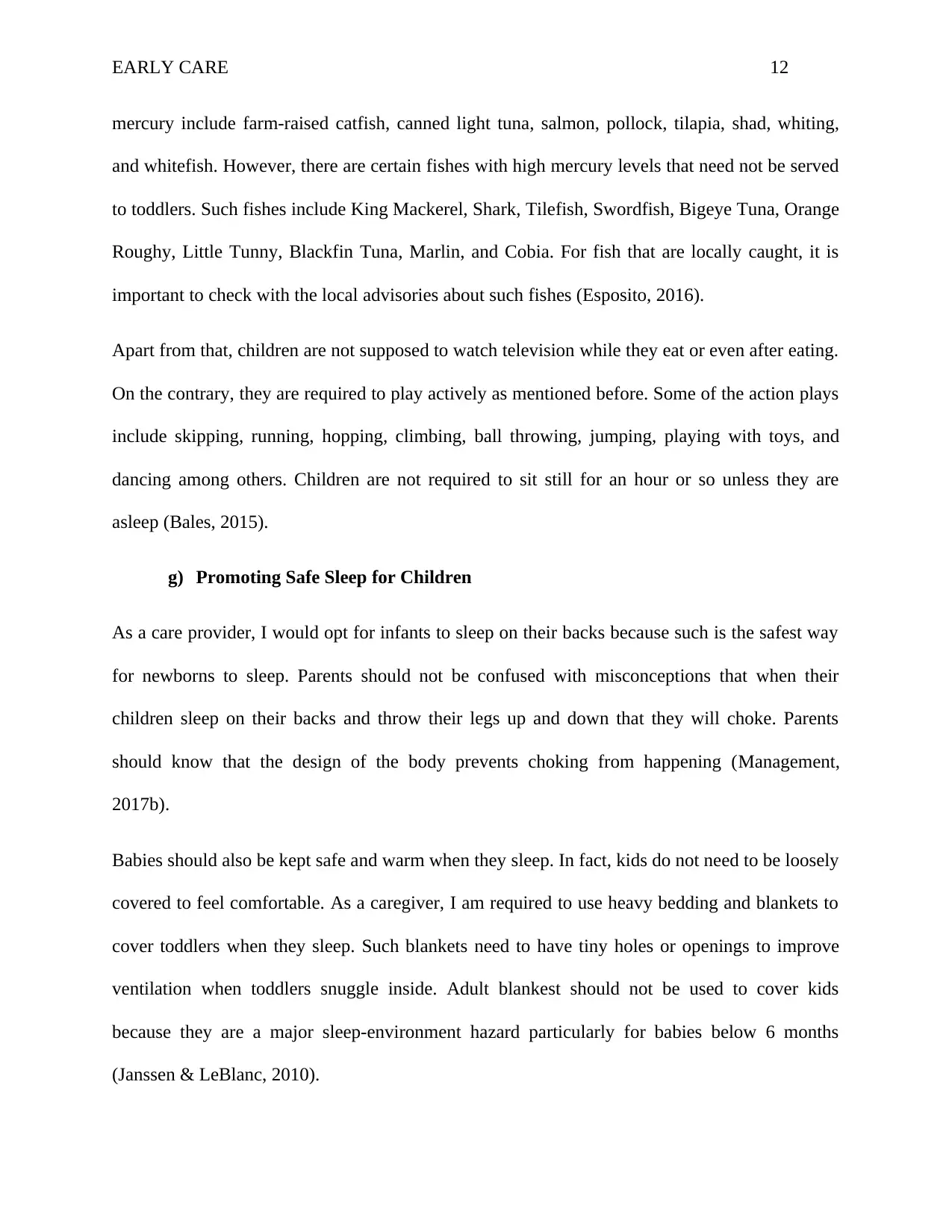
EARLY CARE 12
mercury include farm-raised catfish, canned light tuna, salmon, pollock, tilapia, shad, whiting,
and whitefish. However, there are certain fishes with high mercury levels that need not be served
to toddlers. Such fishes include King Mackerel, Shark, Tilefish, Swordfish, Bigeye Tuna, Orange
Roughy, Little Tunny, Blackfin Tuna, Marlin, and Cobia. For fish that are locally caught, it is
important to check with the local advisories about such fishes (Esposito, 2016).
Apart from that, children are not supposed to watch television while they eat or even after eating.
On the contrary, they are required to play actively as mentioned before. Some of the action plays
include skipping, running, hopping, climbing, ball throwing, jumping, playing with toys, and
dancing among others. Children are not required to sit still for an hour or so unless they are
asleep (Bales, 2015).
g) Promoting Safe Sleep for Children
As a care provider, I would opt for infants to sleep on their backs because such is the safest way
for newborns to sleep. Parents should not be confused with misconceptions that when their
children sleep on their backs and throw their legs up and down that they will choke. Parents
should know that the design of the body prevents choking from happening (Management,
2017b).
Babies should also be kept safe and warm when they sleep. In fact, kids do not need to be loosely
covered to feel comfortable. As a caregiver, I am required to use heavy bedding and blankets to
cover toddlers when they sleep. Such blankets need to have tiny holes or openings to improve
ventilation when toddlers snuggle inside. Adult blankest should not be used to cover kids
because they are a major sleep-environment hazard particularly for babies below 6 months
(Janssen & LeBlanc, 2010).
mercury include farm-raised catfish, canned light tuna, salmon, pollock, tilapia, shad, whiting,
and whitefish. However, there are certain fishes with high mercury levels that need not be served
to toddlers. Such fishes include King Mackerel, Shark, Tilefish, Swordfish, Bigeye Tuna, Orange
Roughy, Little Tunny, Blackfin Tuna, Marlin, and Cobia. For fish that are locally caught, it is
important to check with the local advisories about such fishes (Esposito, 2016).
Apart from that, children are not supposed to watch television while they eat or even after eating.
On the contrary, they are required to play actively as mentioned before. Some of the action plays
include skipping, running, hopping, climbing, ball throwing, jumping, playing with toys, and
dancing among others. Children are not required to sit still for an hour or so unless they are
asleep (Bales, 2015).
g) Promoting Safe Sleep for Children
As a care provider, I would opt for infants to sleep on their backs because such is the safest way
for newborns to sleep. Parents should not be confused with misconceptions that when their
children sleep on their backs and throw their legs up and down that they will choke. Parents
should know that the design of the body prevents choking from happening (Management,
2017b).
Babies should also be kept safe and warm when they sleep. In fact, kids do not need to be loosely
covered to feel comfortable. As a caregiver, I am required to use heavy bedding and blankets to
cover toddlers when they sleep. Such blankets need to have tiny holes or openings to improve
ventilation when toddlers snuggle inside. Adult blankest should not be used to cover kids
because they are a major sleep-environment hazard particularly for babies below 6 months
(Janssen & LeBlanc, 2010).
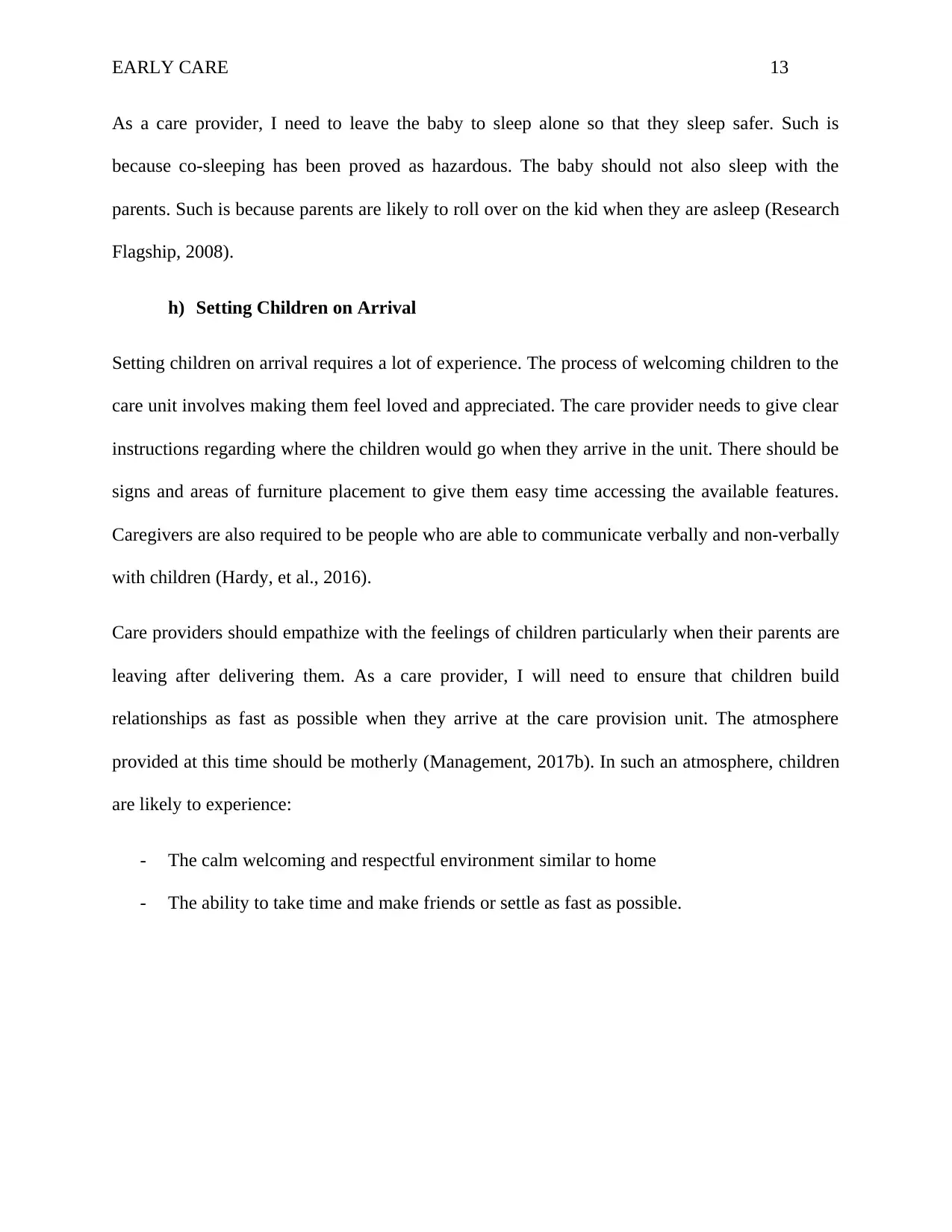
EARLY CARE 13
As a care provider, I need to leave the baby to sleep alone so that they sleep safer. Such is
because co-sleeping has been proved as hazardous. The baby should not also sleep with the
parents. Such is because parents are likely to roll over on the kid when they are asleep (Research
Flagship, 2008).
h) Setting Children on Arrival
Setting children on arrival requires a lot of experience. The process of welcoming children to the
care unit involves making them feel loved and appreciated. The care provider needs to give clear
instructions regarding where the children would go when they arrive in the unit. There should be
signs and areas of furniture placement to give them easy time accessing the available features.
Caregivers are also required to be people who are able to communicate verbally and non-verbally
with children (Hardy, et al., 2016).
Care providers should empathize with the feelings of children particularly when their parents are
leaving after delivering them. As a care provider, I will need to ensure that children build
relationships as fast as possible when they arrive at the care provision unit. The atmosphere
provided at this time should be motherly (Management, 2017b). In such an atmosphere, children
are likely to experience:
- The calm welcoming and respectful environment similar to home
- The ability to take time and make friends or settle as fast as possible.
As a care provider, I need to leave the baby to sleep alone so that they sleep safer. Such is
because co-sleeping has been proved as hazardous. The baby should not also sleep with the
parents. Such is because parents are likely to roll over on the kid when they are asleep (Research
Flagship, 2008).
h) Setting Children on Arrival
Setting children on arrival requires a lot of experience. The process of welcoming children to the
care unit involves making them feel loved and appreciated. The care provider needs to give clear
instructions regarding where the children would go when they arrive in the unit. There should be
signs and areas of furniture placement to give them easy time accessing the available features.
Caregivers are also required to be people who are able to communicate verbally and non-verbally
with children (Hardy, et al., 2016).
Care providers should empathize with the feelings of children particularly when their parents are
leaving after delivering them. As a care provider, I will need to ensure that children build
relationships as fast as possible when they arrive at the care provision unit. The atmosphere
provided at this time should be motherly (Management, 2017b). In such an atmosphere, children
are likely to experience:
- The calm welcoming and respectful environment similar to home
- The ability to take time and make friends or settle as fast as possible.
Paraphrase This Document
Need a fresh take? Get an instant paraphrase of this document with our AI Paraphraser

EARLY CARE 14
Reference
Australian Government (2017). Australia’s physical activity and sedentary behaviour guidelines.
Department of Health - Canberra: Australian Government Department of Health.
Retrieved 9 February 2018 from
http://www.health.gov.au/internet/main/publishing.nsf/Content/health-pubhlth-strateg-
phys-act-guidelines. [Accessed September 26, 2018]
Bales, D (2015)10 Steps to Change a Diaper in a Child Care Setting. Extension. Retrieved 9
February 2018 from https://articles.extension.org/pages/25738/10-steps-to-change-a-
diaper-in-a-child-care-setting [Accessed September 26, 2018]
Esposito, L. (2016). How to Promote Safe Sleep for Your Infant. US NEWS. Retrieved 9
February 2018 from https://health.usnews.com/wellness/slideshows/how-to-promote-
safe-sleep-for-your-infant?slide=6 [Accessed September 26, 2018]
Hardy, L.L., Mihrshahi, S., Drayton, B.A., & Bauman, A. (2016). NSW schools physical activity
and nutrition survey (SPANS): Full report. Sydney: NSW Department of Health.
Retrieved 9 February 2018 from http://www.health.nsw.gov.au/heal/Pages/spans-2015-
full-report.aspx [Accessed September 26, 2018]
Janssen, I., & LeBlanc, A.G. (2010). A systematic review of the health benefits of physical
activity and fitness in school-aged children and youth. International Journal of Behavioral
Nutrition and Physical Activity, Vol 7, 40. doi: 10.1186/1479-5868-7-40 [Accessed
September 26, 2018]
Reference
Australian Government (2017). Australia’s physical activity and sedentary behaviour guidelines.
Department of Health - Canberra: Australian Government Department of Health.
Retrieved 9 February 2018 from
http://www.health.gov.au/internet/main/publishing.nsf/Content/health-pubhlth-strateg-
phys-act-guidelines. [Accessed September 26, 2018]
Bales, D (2015)10 Steps to Change a Diaper in a Child Care Setting. Extension. Retrieved 9
February 2018 from https://articles.extension.org/pages/25738/10-steps-to-change-a-
diaper-in-a-child-care-setting [Accessed September 26, 2018]
Esposito, L. (2016). How to Promote Safe Sleep for Your Infant. US NEWS. Retrieved 9
February 2018 from https://health.usnews.com/wellness/slideshows/how-to-promote-
safe-sleep-for-your-infant?slide=6 [Accessed September 26, 2018]
Hardy, L.L., Mihrshahi, S., Drayton, B.A., & Bauman, A. (2016). NSW schools physical activity
and nutrition survey (SPANS): Full report. Sydney: NSW Department of Health.
Retrieved 9 February 2018 from http://www.health.nsw.gov.au/heal/Pages/spans-2015-
full-report.aspx [Accessed September 26, 2018]
Janssen, I., & LeBlanc, A.G. (2010). A systematic review of the health benefits of physical
activity and fitness in school-aged children and youth. International Journal of Behavioral
Nutrition and Physical Activity, Vol 7, 40. doi: 10.1186/1479-5868-7-40 [Accessed
September 26, 2018]
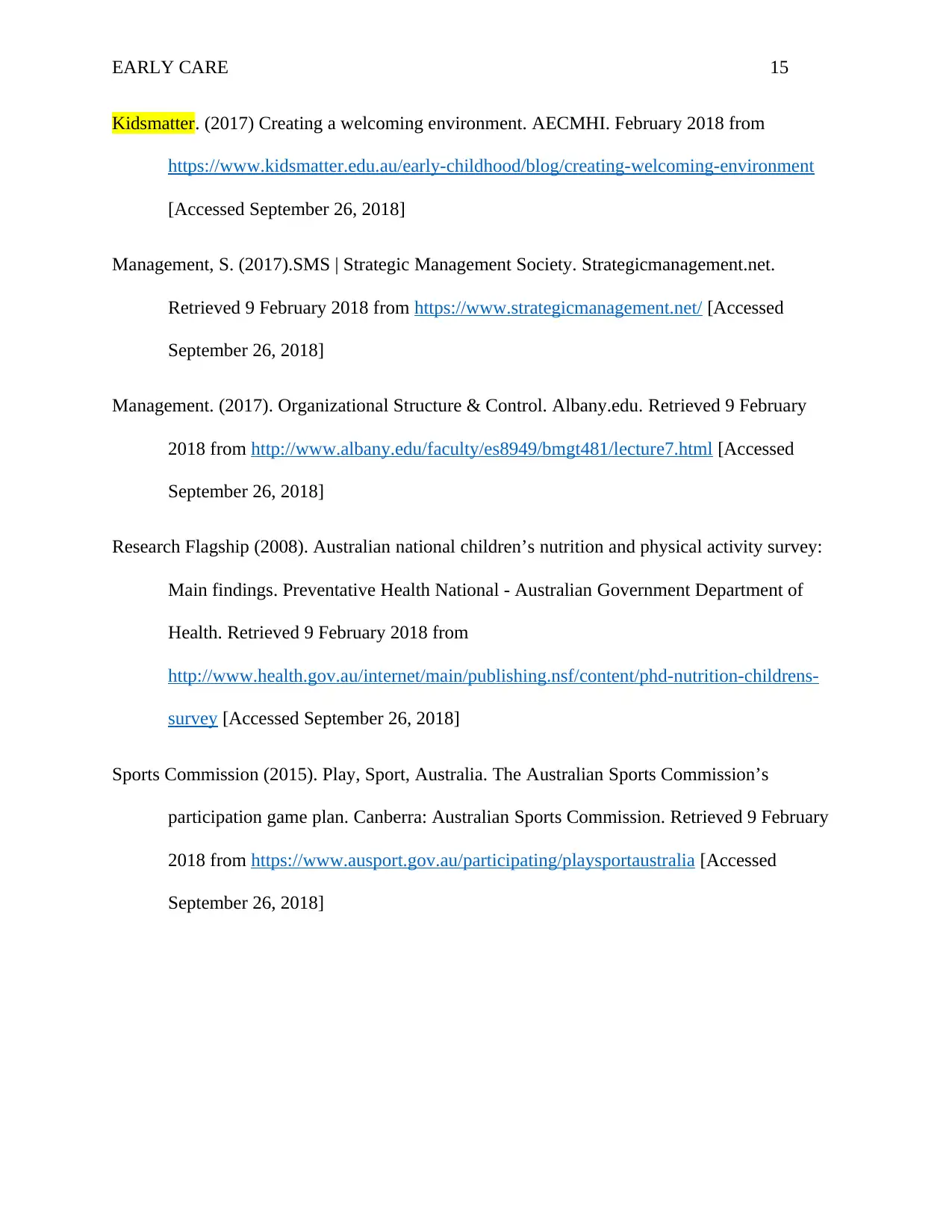
EARLY CARE 15
Kidsmatter. (2017) Creating a welcoming environment. AECMHI. February 2018 from
https://www.kidsmatter.edu.au/early-childhood/blog/creating-welcoming-environment
[Accessed September 26, 2018]
Management, S. (2017).SMS | Strategic Management Society. Strategicmanagement.net.
Retrieved 9 February 2018 from https://www.strategicmanagement.net/ [Accessed
September 26, 2018]
Management. (2017). Organizational Structure & Control. Albany.edu. Retrieved 9 February
2018 from http://www.albany.edu/faculty/es8949/bmgt481/lecture7.html [Accessed
September 26, 2018]
Research Flagship (2008). Australian national children’s nutrition and physical activity survey:
Main findings. Preventative Health National - Australian Government Department of
Health. Retrieved 9 February 2018 from
http://www.health.gov.au/internet/main/publishing.nsf/content/phd-nutrition-childrens-
survey [Accessed September 26, 2018]
Sports Commission (2015). Play, Sport, Australia. The Australian Sports Commission’s
participation game plan. Canberra: Australian Sports Commission. Retrieved 9 February
2018 from https://www.ausport.gov.au/participating/playsportaustralia [Accessed
September 26, 2018]
Kidsmatter. (2017) Creating a welcoming environment. AECMHI. February 2018 from
https://www.kidsmatter.edu.au/early-childhood/blog/creating-welcoming-environment
[Accessed September 26, 2018]
Management, S. (2017).SMS | Strategic Management Society. Strategicmanagement.net.
Retrieved 9 February 2018 from https://www.strategicmanagement.net/ [Accessed
September 26, 2018]
Management. (2017). Organizational Structure & Control. Albany.edu. Retrieved 9 February
2018 from http://www.albany.edu/faculty/es8949/bmgt481/lecture7.html [Accessed
September 26, 2018]
Research Flagship (2008). Australian national children’s nutrition and physical activity survey:
Main findings. Preventative Health National - Australian Government Department of
Health. Retrieved 9 February 2018 from
http://www.health.gov.au/internet/main/publishing.nsf/content/phd-nutrition-childrens-
survey [Accessed September 26, 2018]
Sports Commission (2015). Play, Sport, Australia. The Australian Sports Commission’s
participation game plan. Canberra: Australian Sports Commission. Retrieved 9 February
2018 from https://www.ausport.gov.au/participating/playsportaustralia [Accessed
September 26, 2018]
1 out of 15
Your All-in-One AI-Powered Toolkit for Academic Success.
+13062052269
info@desklib.com
Available 24*7 on WhatsApp / Email
![[object Object]](/_next/static/media/star-bottom.7253800d.svg)
Unlock your academic potential
© 2024 | Zucol Services PVT LTD | All rights reserved.